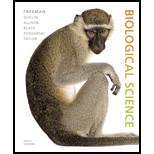
Concept explainers
In antenna complexes, how is energy transferred among the pigment molecules?
a. by heat
b. by
c. by fluorescence
d. by resonance
Introduction:
Antenna complexes, also known as the light-harvesting complexes, are protein and pigment complexes present in thylakoid membrane of plants that transfer the electrons to the electron acceptor at the photosynthetic reaction center.
Answer to Problem 1TYK
Correct answer:
By resonance.
Explanation of Solution
Explanation/Justification for the correct answer:
Option (d) is given by resonance. The light-sensitive molecules are also called chromophores. The antenna complex pigments absorb the photons from the incoming solar radiation, which then transfers the associated energy to the nearby chlorophyll molecule. This results in the excitation of another electron. Hence, option (d) is correct.
Explanation for incorrect answers:
Option (a) is given as by heat. The heat energy from the incoming solar radiation is not absorbed by the chromophore molecule (antenna complex); thus, it cannot transfer the heat energy for the excitation of the electron in the chlorophyll. So, it is a wrong answer.
Option (b) is given as redox reactions. The redox reactions involve the transfer of energy by the transfer of the electrons and the fluorescence energy transfer involves the transfer of the light energy. So, it is a wrong answer.
Option (c) is given as fluorescence. Furthermore, it is not responsible for the excitation of the electron in the chlorophyll as a result of the transfer of energy from the antenna complex. So, it is a wrong answer.
Hence, options (a), (b), and (c) are incorrect.
The mechanism of transfer of the energy among the molecules that are light sensitive is referred to as resonance or fluorescence resonance energy transfer.
Want to see more full solutions like this?
Chapter 10 Solutions
Biological Science (6th Edition)
- What is the energy of a photon first used to do in photosynthesis? a. split a water molecule b. energize an electron c. produce ATP d. synthesize glucosearrow_forwardIn essay form, How can other organisms survive without sunlight and photosynthesis?arrow_forwardWhich best describes cyclic photophosphorylation? (a) it uses two photosystems (b) it produces water as a waste product (c) it produces oxygen as a waste product (d) it utilizes a single photosystem (e) it uses substrate level phosphorylation to produce ATParrow_forward
- The process of electrons passing energy to electrons in the neighboring pigment molecules is known as. A. Activation energy B. Resonance C. Photon transfer D. Fluorescencearrow_forwardAre chloroplast moving or stationary? Make an inference to explain thisarrow_forwardIf you could measure pH within a chloroplast, where would it be lowest? a. In the stroma b. In the lumen of the thylakoid c. In the cytoplasm immediately outside the chloroplast d. In the antenna complexarrow_forward
- Which ranges represent wavelengths of light plants use for photosynthesis? You can choose multiple answers Question 27 options: 400-500nm 500-600nm 620-650nmarrow_forwardWhere does the energy come from to drive photosynthesis?a. A chloroplast c. The sunb. ATP d. Glucosearrow_forwardBased on the diagram, which sentence BEST describes this organism? A. It is a prokaryote that can perform photosynthesis. B. It is a eukaryote that can perform photosynthesis. C. It is a prokaryote that cannot perform photosynthesis. D. It is a eukaryote that cannot perform photosynthesis.arrow_forward
- Use the data to create a graph in Excel. It should be a scatter plot with a line connecting each point. Looking at the graph: a/ Which wavelengths absorbed most by spinach and likely used for photosynthesis? b/ Which wavelengths are absorbed least?arrow_forwardSelect the best answer describing the role of light in photosynthesis a.It is the source of respiration b.It is the source of carbon for the reaction c.It is the source of energy for the reaction d. all of thesearrow_forwardEngelmann's experiment was designed to determine ___. What wavelengths comprise visible light what colors attract bacteria if bacteria are attracted to oxygen if photosynthesis releases oxygen if photosynthesis is impacted by the color of lightarrow_forward
 Concepts of BiologyBiologyISBN:9781938168116Author:Samantha Fowler, Rebecca Roush, James WisePublisher:OpenStax College
Concepts of BiologyBiologyISBN:9781938168116Author:Samantha Fowler, Rebecca Roush, James WisePublisher:OpenStax College
